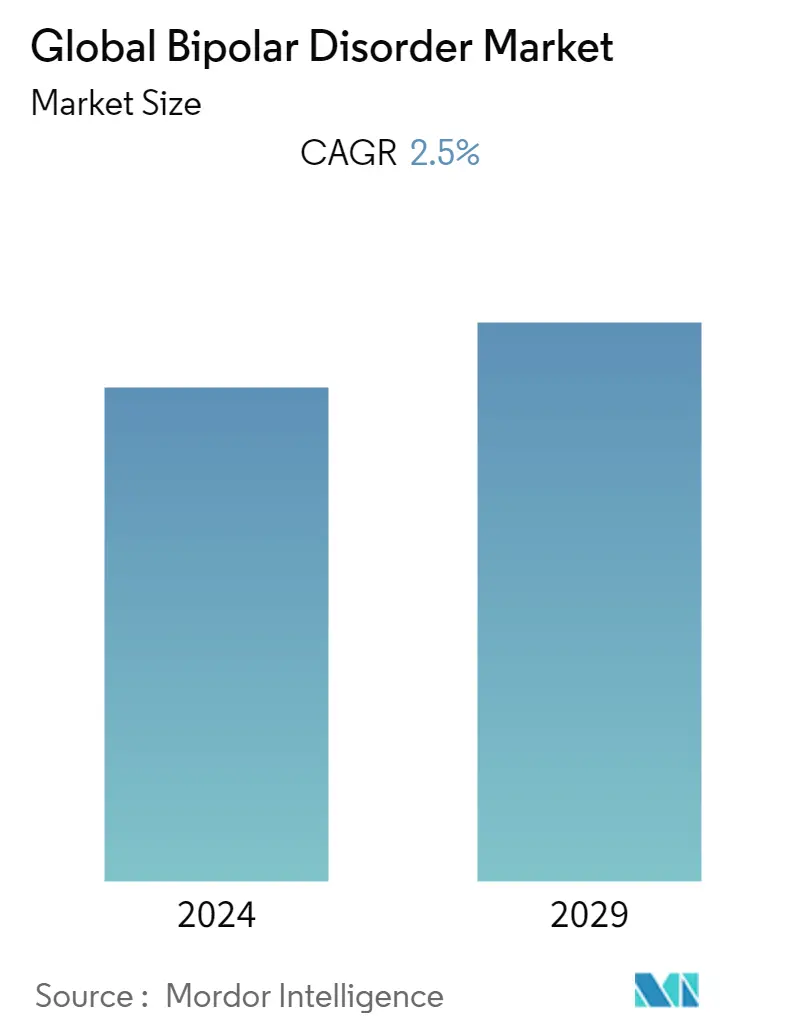Market Size of Global Bipolar Disorder Industry

| Study Period | 2019 - 2029 |
| Base Year For Estimation | 2023 |
| Forecast Data Period | 2024 - 2029 |
| CAGR | 2.50 % |
| Fastest Growing Market | Asia-Pacific |
| Largest Market | North America |
Major Players
*Disclaimer: Major Players sorted in no particular order |
Need a report that reflects how COVID-19 has impacted this market and its growth?
Bipolar Disorder Market Analysis
The bipolar disorder market is expected to register a CAGR of nearly 2.5% during the forecast period.
The Covid-19 pandemic limits had a minor negative impact on the market for medications and treatments for bipolar illness. An article titled 'Implications of the COVID-19 pandemic for people with bipolar disorders: A scoping review' published in September 2021, focused on the impact of social isolation, restrictive measures, lifestyle, and biological circadian rhythms changes due to the COVID-19 pandemic, or infection-related concerns, on the clinical course of bipolar disorder (BD). Some studies found that bipolar disorder (BD) patients reported low rates of relapse or symptom worsening during the pandemic, or less severe psychiatric symptoms and higher feelings of well-being during the pandemic when compared to the pre-pandemic period. When compared to people diagnosed with major depressive disorder (MDD), bipolar disorder (BD) patients exhibited lower psychological distress.
The major factors for the growth of. the bipolar disorder market includes the increasing prevalence of the bipolar disorder, rising initiatives by government institutes to increase awareness, and technological advancements. As per an article titled 'What is the worldwide prevalence of bipolar disorder?' published in October 2021, bipolar disorder has a lifetime prevalence of about 1% and a one-year prevalence of about 0.5% worldwide. Bipolar I disorder has greater rates than bipolar II disorder.According to World Health Organization (WHO) key facts updated in June 2022, 1 in every 8 people in the world live with a mental disorder. Due to the COVID-19 pandemic, the number of people who suffer from anxiety and depressive illnesses greatly increased in 2020. Initial projections indicate a 26% and 28% increase in depressive disorders and anxiety, respectively, in just one year. As per the same source, in 2020, 40 million people experienced bipolar disorder. People with bipolar disorder experience alternating depressive episodes with periods of manic symptoms. As per an article titled 'The prevalence and clinical correlates of medical disorders comorbidities in patients with bipolar disorder' published in March 2022, Medical problems are very common in Chinese bipolar disorder (BD) sufferers. The concomitant medical diseases in BD patients relate to smoking, the frequency of depressive episodes, the onset age, and the duration of the illness. Clinicians should be aware of the co-occurring medical conditions in BD patients and take appropriate action to enhance treatment outcomes and lessen suffering.
Most of the healthcare industry's resources and professionals were directed toward the control of the Covid-19 threat because there were numerous positive cases of individuals who had been infected by the new Corona Virus. Particularly, there was a sharp decline in hospital and healthcare institution demand for bipolar medications. Surprisingly, during the global ban on the free movement of people, the number of patients with bipolar disorders surged considerably. This assumption is based on data indicating a rise in the quantity of over-the-counter bipolar medications available during pandemic periods. However, the expansion of the availability of bipolar medications on e-commerce sites maintains the market growth for prescription pharmaceuticals.
There is an increasing prevalence of bipolar disorder owing to the various risk factors, such as substance abuse, high stress, and others. The typical age of onset is the late teens or the early 20s, and depression is common in people diagnosed with bipolar. The probability of men and women being affected by bipolar disorder is similar. Therfore, the rise in the cases of the disease and the increasing need to manage them effectively has led to the growth of the bipolar disorder market. Although many of the medications used to treat bipolar disorder have linked adverse effects, these include drug addiction, diabetes and cholesterol problems, blurred vision, and liver and thyroid damage, among others. A handful of the medications have also been associated in studies with serious side effects such as kidney failure and teratogenic effects on the fetus when taken by pregnant women. Additionally, bipolar illness may frequently be misdiagnosed as depression or a personality problem, which may reduce the rates of both diagnosis and treatment for this mental disorder.
